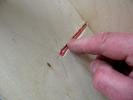Question: I am building my second dollhouse, and I'm attempting to put lights and wall outlets in this one.
I read the article about cocktail staw conduits. Rather than carving channels for the straws and then covering them with filler, is it possible
to drill holes in the walls?
My husband is concerned that the walls and floors will fall apart if we try
to cut tunnels into it.
Thanks!
3/8 floors and walls can be grooved half way thru in most "cocktail straw" applications
because cocktail straws are only 6" long (which means they have a 5"
effective working length) and that leaves plenty of material for strength. In practice, coctail straw wiring is only useful when you are
close to a target.
Traditional solidwire installations do shallow grooves behind the baseboards
for most of the wiring. They drill thru the ceiling for ceiling lights,
paint the ceiling and install the lights and run the wires across the floor.
Then they put applied flooring over the wires, make the connections along
the baseboard space, and put on baseboards. The final drop would be along
the back edge of the wall in a shallow groove, down to the cellar, and would
use a buss bar in the cellar to hook all the wires together.
Pros of this kind of wiring:
- there's no mystery in the installation of the fixtures... fixtures come with
a piece of wire attached.
- connections are robust... other wiring systems require more attention to make good
connections
- cost... a bit of extra wire and a buss bar (radio shack) is all you need
over and above the fixtures
Cons of this kind of wiring
- inflexibility... you have to know exactly what you want and where it is
going early in the project, and you can't re-decorate easily in years to come
- up-front cost... you have to already own all the lights you intend to use
-
long term service... if you break a fixture it is very difficult to replace
it
It requires buying applied flooring ($$), which is not always what the
builder is intending
-In
a large project, the attached wires on the fixtures are not long enough, so
you must solder on lengths of wire and use shrink tubing to insulate the
joint
Tapewire and cocktail-straw wiring overcome some of these liabilities.
Typically, if I am doing a small, easy to plan project, I choose one of the
solidwire variations. The cocktail straw demo in the website was perfect
for that technique. On bigger houses with lots of lights, or where I am
building a house into which someone else will install fixtures, then I
choose tapewire for its flexibility.
I hope this helps
doc







